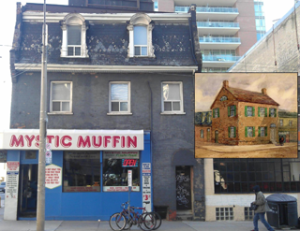 So much of our early past has been demolished in the name of progress there are few buildings and even fewer institutions in Toronto that can date themselves back to our 18th century European beginnings; however there is one building that encompasses both.
So much of our early past has been demolished in the name of progress there are few buildings and even fewer institutions in Toronto that can date themselves back to our 18th century European beginnings; however there is one building that encompasses both.
By today’s standards it’s a very nondescript building, hiding amongst its more modern neighbours at a very busy intersection. Unlike the surrounding expressways, skyscrapers and condos, this building is almost 200 years old.
Most in its neighbourhood know this historic structure at 113 Jarvis (southeast corner of Jarvis and Richmond) as the Mystic Muffin, a tasty Middle Eastern eatery owned by Lebanese-born Elias Makhou. Since 1993, when it was built in 1832, it was the home of the first Catholic priest in Toronto, Father Alexander Macdonell.
Toronto’s Catholic roots date back to the early 1700s when French fur traders settled on the banks of the Humber River during the reign of King Louis XIV (the Sun King).
In 1793 the British arrived and even though the Anglican Church becomes the dominant religious force for the next 100 years, Catholicism did flourish.
In 1806 the Reverend Alexander Macdonell, the only Catholic Priest in Upper Canada (later to become its first Catholic bishop), left his parish in Glengarry in eastern Ontario to visit York.
On his return he reported to his superior Reverend J.O. Plessis, Bishop of Quebec, that York had only 37 Catholics in a town of approximately 200 people, many of whom had never seen a priest.
Immediately a plot of land on the northeast corner of George and Duke (now Adelaide) was granted from the Crown to four Catholic trustees on March 28, 1806 for the purpose of erecting a chapel for public worship.
 No records show how the church looked or even its official opening date around 1807, but the church was there by the time the Americans arrived in April 1813 for their week-long occupation of the Town of York during the War of 1812.
No records show how the church looked or even its official opening date around 1807, but the church was there by the time the Americans arrived in April 1813 for their week-long occupation of the Town of York during the War of 1812.
The church was destroyed by fire after the war and the lot went unused with services held in the homes of various church elders.
By 1822 the Catholic population had grown to over 1000 people and the trustees of the church lot decided to sell the plot because it was too small to build a church for the ever-increasing congregation.
The elders sold the lot to Sir William Campbell who was building his home just east of George Street (Campbell’s house still stands but was moved to the corner of University and Queen in 1972) who in turn sells the land for the construction of the present Bank of Upper Canada building in 1825 (northeast corner of Adelaide and George presently undergoing a massive renovation).
The money the Catholic elders received was used to buy a 10-acre site south of Queen just east of Parliament Street to build the first St Paul’s Church in 1824 on present day Power Street.
Toronto’s first Catholic priest (later Bishop) Father Alexander Macdonell was born in Scotland in 1762, ordained a priest in February 1787 and arrived in Quebec in 1804.
Although christened as Alexander Mcdonell, later he changed it to Alexander Macdonell. Over the years because his was such a common name, there are various spellings that appear in the history books.
In 1815, Macdonell began his service as the first Roman Catholic Bishop at St. Raphael’s Church, located in South Glengarry, a township in eastern Ontario on the St. Lawrence River.
In 1828 after a few visits here to York Father Macdonell arrived permanently and by 1832 had built a fine home on what is now the southeast corner of Richmond and Jarvis Street (now Mystic Muffin).
In 1839 he left for Scotland and Ireland with hopes of raising funds for his seminary, Regiopolis College, but took sick while in Dublin, returned to Scotland and died there from pneumonia on Jan. 14, 1840 at the age 77.
In 1841 the Diocese of Toronto was created and its first Bishop installed Father Michael Power who would serve until his death in 1847.
As the 19th century came to a close Toronto, still very British to its core, reluctantly started to open its doors. Soon Italians, Greeks, Turks and Russians started to flock to our city.
It was also this time that the former Bishop’s home on Jarvis underwent a radical change with an addition of a French-inspired mansard roof still seen today.
By the 1920s, once-glamorous Jarvis Street was in decline and Bishop Macdonell’s former home was transformed into the Service Sandwich Shop owned by Al Pivnick.
During the Great Depression of the 1930s Al sold his business to John Dimson who took over the running of the sandwich shop, remodelled the upstairs and rented it out to a jeweller. John Dimson, born in 1893 arrived in Canada from Greece in 1919, married Beatrice Porter and had six children.
Following a lifetime of making sandwiches for the neighbourhood, John Dimson died in the shop in 1963 of a heart attack. In 1993 Elias Makhoul bought the restaurant. Then during the recession of 2007, and after an unsuccessful run for the mayor’s office, Elias and his wife Annie offered free meals and cooking classes to regular customers recently laid off from their jobs.
Today the one-time residence of an 18th-century priest from Scotland stands as a testament to the true essence of our city—a tangible multicultural link to our past and home to the best apple cake in Toronto.
 TheBulletin.ca Journal of Downtown Toronto
TheBulletin.ca Journal of Downtown Toronto

